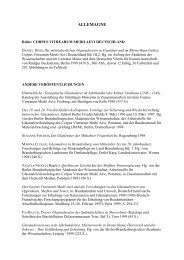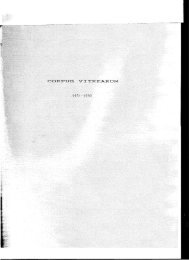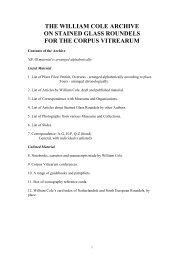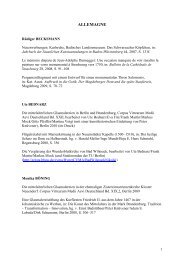BristolConference - Corpus Vitrearum Medii Aevi
BristolConference - Corpus Vitrearum Medii Aevi
BristolConference - Corpus Vitrearum Medii Aevi
Create successful ePaper yourself
Turn your PDF publications into a flip-book with our unique Google optimized e-Paper software.
Dr Ivo Rauch<br />
(Koblenz)<br />
Translozierte rheinische Clasmalereien in Shrewsbury (Shropshire).<br />
Stiftungen der Trierer Domkanoniker for die Andreas- und Stephanuskapelle in Trier<br />
Die Marienkirche van Shrewsbury (Shropshire) besitzt eine groBeAnzahl kontinentaler<br />
Glasmalereien, die der in der 1. Halfte des 19. Jh. dort tatige Vikar William Gorsuch Rowland<br />
vermutlich im Kunsthandel angekauft hatte. Unter anderem befinden sich dort 43 Scheiben,<br />
die offenbar von Trierer Domkanonikem um 1478/79 gestiftet worden waren. Man glaubte<br />
daher bislang, daB diese Fenster zur ursprlinglichen Verglasung des Trierer Doms gehorten.<br />
Anhand genauer Bestandsaufnahmen und ikonographischer Analysen kann jedoch gezeigt<br />
werden, daf diese Scheiben keineswegs aus dem Trierer Dom stammen sondem gleichzeitig<br />
fur die Andreas- und die Stephanuskapelle im Dombezirk geschaffen wurden. Diese<br />
Kirchenraume wurden 1792 bzw. 1806 abgerissen. Die in Shrewsbury gefundenen<br />
Glasmalereien wurden von den Amtstragern, den Dignitates des Kathedralkapitels fur diese<br />
beiden Kapellen gestiftet.<br />
Obwohl zur gleichen Zeit und von einer Personengruppe gestiftet, beauftragte man mit der<br />
Ausfiihrung verschiedene Werkstatten. Die Scheiben der Stephanuskapelle wurden<br />
vermutlich von einer mittelrheinischen Werkstatt angefertigt, die enge Zusammenhange mit<br />
den Scheiben der Bopparder Karmeliterkirche (heute Koln, Darmstadt, Glasgow, New York)<br />
aufweist. Die Glasmalereien der Andreaskapelle dagegen stammen wohl aus einer Kolner<br />
Werkstatt, die neueste Kunsttendenzen um 1480 kannte und verarbeitete. Insbesondere die<br />
Tafelmalereien aus dem Umkreis des Meisters des Marienlebens und der Georgslegende<br />
waren fur diesen Stil pragend.<br />
Es ist hier erstmals gelungen, sowohl den ursprunglichen Standort dieser Scheibengruppe<br />
aus St. Mary's Church in Shrewsbury zu bestimmen, als auch die kunstlerische Herkunft<br />
der Glasmalereien zu benennen. Auf diesel' Basis kann weitergefragt werden nach der<br />
Motivation der Stifter, der liturgischen und sozialen Funktion der Scheiben und der<br />
Kapellenraume, fur die sie geschaffen word en waren.<br />
Relocated Rhenish Glass in Shrewsbury:<br />
in Trier, 1478-79<br />
The Canons' Gift to the Chapels of ss Andrew and Stephen<br />
The Church of St Mary in Shrewsbury (Shropshire) contains a large amount of Continental<br />
stained glass which was acquired, presumably on the art market, in the first half of the<br />
19 th century by the vicar, William Gorsuch Rowland. Among others, there are 43 panels<br />
apparently donated by the canons of Trier Cathedral in 1478-79. Until recently therefore,<br />
it was thought that these windows originally belonged to the glass of Trier Cathedral.<br />
As a result of a closer study of the provenance and iconography, however, it can now be<br />
shown that these windows did not come from Trier Cathedral but, rather, were made for<br />
the chapels of SSAndrew and Stephen in the cathedral precinct. These chapels were<br />
demolished in 1792-1806. The glass now in Shrewsbury was given to these chapels by the<br />
responsible officials, the dignitates of the Cathedral chapter.<br />
Although the glass was given at one time and by a single group of donors, several workshops<br />
were involved. The panels from St Stephen's chapel were presumably made by a middle<br />
Rhenish workshop closely connected with the glass of the Cannelite church in Boppard (now<br />
in Cologne, Darmstadt, Glasgow and New York).The St Andrew's Chapel glass, on the other<br />
hand, most probably came from a Cologne workshop which produced work in the most up to<br />
date stylistic conventions of c.1480. In particular, the panel paintings in the circle of the Master<br />
of the Life of the Virgin and the Master of the Legend of St George bear the stamp of this style.<br />
This is the first time that it has been possible to discover both the original home of the<br />
Shrewsbury panels and their stylistic origins. On this basis, one can discuss the motivation<br />
of the donors, the liturgical and social functions of the stained glass and the chapels for<br />
which it was created.<br />
15














